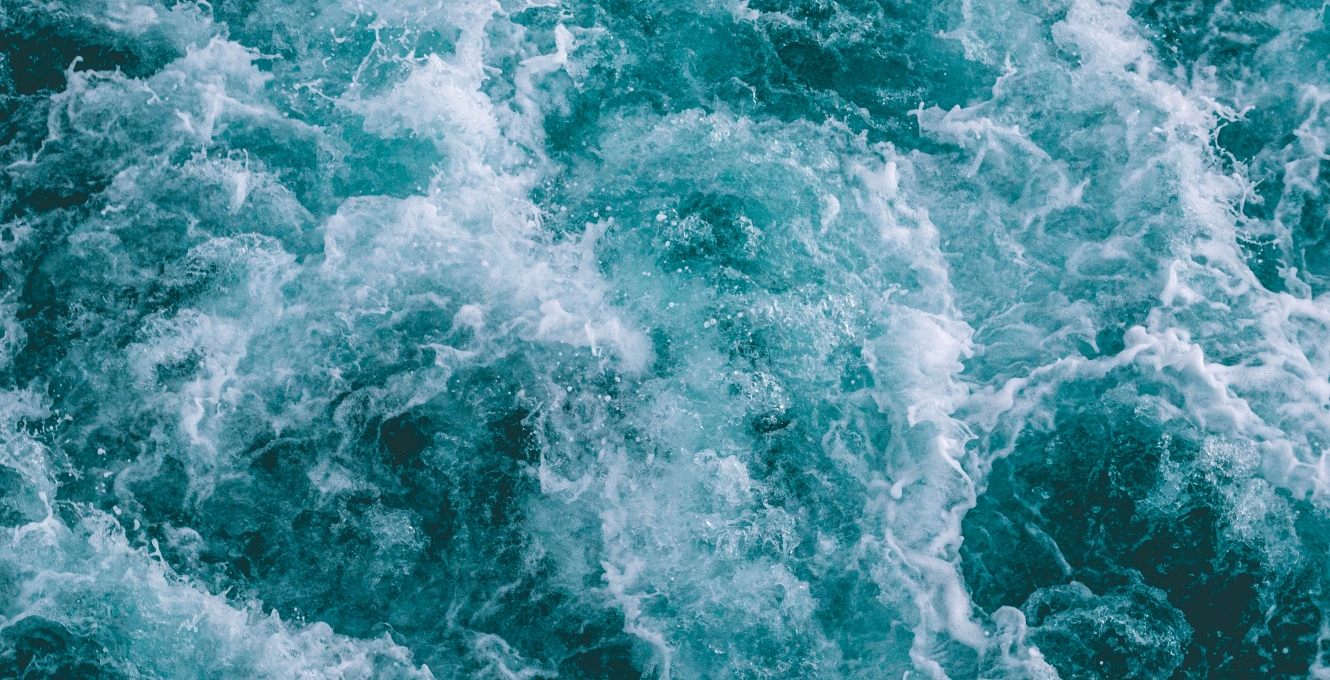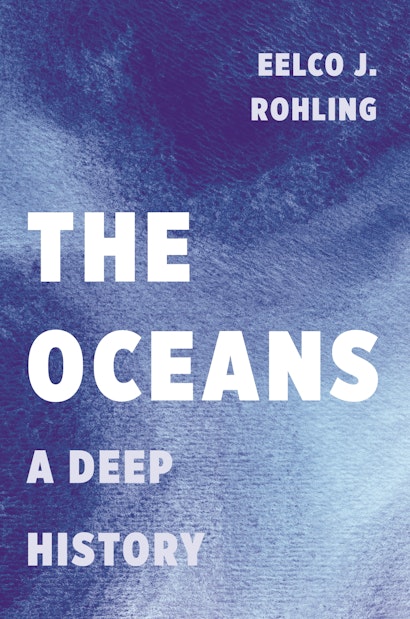Earth’s bodies of water have gone through considerable changes over time. We asked Eelco J. Rohling and Sean W. Fleming if these changes can tell us anything about climate change—and the future.
Eelco J. Rohling, author of The Oceans: A Deep History
Earth’s bodies of water have gone through considerable changes over time—over a lot of time. We have clear geological signs that rivers and lakes have been around for at least 4,400 million years. It never ceases to amaze me that, within 140 million years of its red-hot formation, Earth’s surface had cooled down sufficiently for it to hold fluid water. Then, starting from about 4,000 million years ago, oceans of some shape and form have been around.
Within those ancient bodies of water, life evolved. The earliest signs of life date back to 3,700 million years ago. Then followed a long wait until the first complex life-forms appeared, at around 650 to 700 million years ago. Carbonate coral and shell-reefs became important in shallow waters from about 550 million years ago; many reef systems were formed ever since. And then another major transition took place as late as 125 to 150 million years ago, when carbonate-shelled micro-organisms evolved that rapidly occupied open-ocean surface waters across the world. These organisms are responsible for the formation of geological deposits like the striking white (chalk) cliffs of Dover. Their appearance heralded the start of a fully modern style of operation of the carbon cycle, which includes also atmospheric greenhouse gas concentrations.
Throughout the long history of Earth and its oceans, the carbon cycle and climate changes have been intimately linked. Water is a fantastic substance for absorbing vast quantities of carbon dioxide, and the presence of major bodies of water therefore puts a strong check on greenhouse gas (especially carbon dioxide) concentrations in the atmosphere. Life in the oceans in turn affects the carbon cycle because it involves interaction between dissolved carbon dioxide and both organic matter and carbonate skeletal parts that get (partially) buried and preserved as sediments.
Many ocean sediments eventually get transported into Earth’s hot mantle in subduction zones (think of the Pacific ‘ring of fire,’ where oceanic crust is thrust underneath continental crust). Heating and chemical reactions cause vapour and gas releases, which vent out via volcanoes. This drives up carbon dioxide levels in the atmosphere and in the oceans. The oceanic part goes directly back into the oceanic carbon cycle. The atmospheric part gets involved in rock weathering on land. This consumes carbon dioxide and releases breakdown products (ions) that flow via rivers back to the oceans, where they help new carbonate formation.
It seems a perfect circle, but it isn’t. There are periods of tiny net carbon dioxide losses or gains. You would not be able to measure these from year to year, but over the multi-million-year timescales of Earth history, they add up to large atmospheric carbon dioxide variations. When this goes up, it gets warmer and weathering increases, which then slowly draws down more carbon dioxide (and vice versa). This way, Earth, with the oceans in a central role, regulates the atmospheric carbon dioxide levels under natural circumstances. It still allows for long, warm periods like the time of the dinosaurs, and excessively cold periods like ice ages or—worse—the exceptional Snowball Earth periods of about 700 million years ago. But overall, the intricately inter-linked long-term carbon cycle processes have held Earth within a ‘habitable’ climate range. Everything changed all the time (and sometimes a lot), but the pace of change was always very slow.
Enter humanity, and our fossil-fuel addiction. We have increased atmospheric carbon dioxide levels in an important manner since the start of the industrial revolution, and especially in the last 60 years. We’re not pushing the actual levels beyond the envelope of where they have been in the natural past—not by a long shot, because we’ve gone from 275 to 410 parts per million, while natural variations have been much greater than that. That’s not the worry. The worry is how fast we’re doing it. We’re doing it easily some 30 to 100 times faster than natural processes have ever done it before (even supervolcanoes cannot get close). Even if all natural removal mechanisms were fired up to 100% their known capacity, then they could offset only about one tenth of our annual emissions.
It is clear, then, that we must drastically reduce our emissions. In addition, it is clear that we must rapidly develop and implement major human-assisted processes of carbon drawdown; that is, we must help nature with the clean-up job. This is important first to deal with ongoing residual emissions that are unavoidable (for example, from cement industry or petrochemical manufacturing), and second to draw down a large part of our past emissions. Both new and existing carbon drawdown approaches are desperately needed at large scales to be able to do this. The sheer amount of carbon removal to be done is enormous.
What can we learn from Ocean and Earth history? That we’re ourselves responsible for the current climate change, and that it’s up to us to deal with it. Mother Nature by itself can and will clean up our greenhouse gases, but don’t wait up for it—it will take her several hundred thousands of years even when working flat-out. We urgently need to lend her a helping hand if we want improvement on societally relevant timescales. Doing so will, incidentally, be a major driver for innovation, development, job creation, and growth potential. What an opportunity!
Eelco J. Rohling is professor of ocean and climate change in the Research School of Earth Sciences at the Australian National University and at the University of Southampton’s National Oceanography Centre Southampton.
Sean W. Fleming, author of Where the River Flows: Scientific Reflections on Earth’s Waterways
A common misconception about climate change and its impacts on environmental and social systems, like our rivers and water resources, is that it’s something that will only happen at some point in the future. In reality, climate change is happening now. Not only does climate vary both naturally due to processes like El Niño, and in response to local-scale human activities like urban heat islands, but global anthropogenic greenhouse gas warming has also been going on for generations—and these signals can be directly detected in actual observational datasets!
In fact, doing so is a crucially important part of understanding the reality and broader impacts of climate change. When people talk about climate change, they often talk about climate models: math and software that simulate the global climate system. And because climate models are exactly that—detailed representations of climate, but not of everything climate affects—to understand the impacts on water resources, the predictions of those climate models are taken by hydrologists and other scientists and engineers and run through still other models, such as simulations of watershed hydrology, water quality, habitat quantity and quality, or reservoir operations. All these models are amazing technical feats, and they’re fantastic for isolating the impacts of human-caused global climate change from other sources of environmental variability. But by necessity, they contain a lot of simplifications. Rivers are immensely complex systems that integrate the effects of just about everything in their watersheds, from weather and climate, to forests and icefields, to land use changes like forestry and urban sprawl. It turns out they’re also full of unexpected surprises.
So, while the physics-based virtual realities of process simulation models are great tests of what we know about the world and are our best bet for making predictions based on that knowledge, they can only contain what we know, not what we don’t know. In contrast, drawing sophisticated data analytics algorithms from statistics, digital signal processing, information theory, and artificial intelligence, and applying them to actual measurements of climate and the things it affects, provides a valuable “ground truth”—giving direct empirical evidence for the impacts of climate change on rivers, and often revealing previously unknown patterns that the next generation of models must then seek to explain and, ultimately, predict.
My favorite example is how mountain glaciers control water resource responses to climate change. My doctoral studies began in 2001 with a glacier science expedition to the high peaks of the Yukon-Alaska-British Columbia border region. Hearing summer melt water run deep in the crevasses of Trapridge Glacier and watching white-water streams gushing from its terminus, I decided to focus my research on statistical and machine learning studies of decades-long historical streamflow data in glacial watersheds. The goal was to understand how these gigantic ice cubes modify the downstream expressions of climate change—specifically, by comparing climate variability and change responses in several glacier-fed rivers to a control population of nearby rivers that didn’t have glaciers in their headwaters.
We made a few discoveries. One revelation was that recent global warming affected the net downstream flow of glacial rivers in a completely different way from non-glacial watersheds: glacial rivers grew larger while non-glacial rivers shrank. It was solid evidence of the present reality of climate change, but at the same time, specific patterns like this were poorly represented, if at all, in environmental models. With further refinement by many scientists worldwide, this knowledge has since become part of a standard model of how water resources downstream of mountain glaciers—which lie at the heart of the continental “water towers” of the Rockies, Andes, Alps, and Himalayas, in turn feeding the headwaters of the Columbia, Amazon, Danube, Brahmaputra, and Yangtze rivers, among others—are affected by climate change.
Sean W. Fleming has two decades of experience in the private, public, and nonprofit sectors in the United States, Canada, England, and Mexico, ranging from oil exploration to operational river forecasting to glacier science. He holds faculty positions in the geophysical sciences at the University of British Columbia and Oregon State University.


